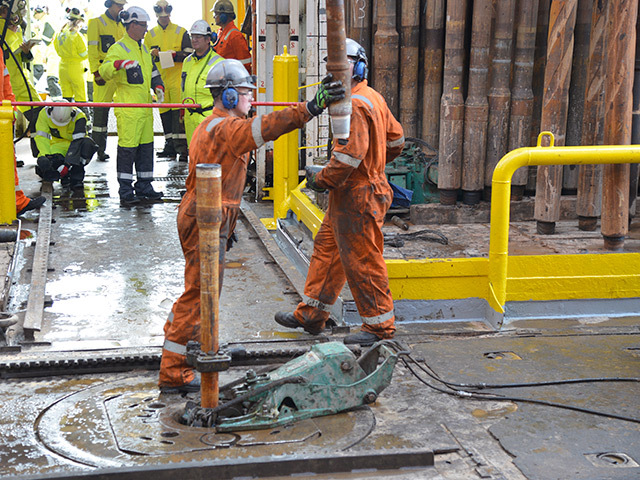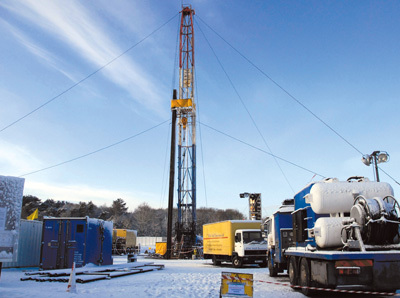
The massive drop in oil prices, combined with cost and cash flow issues among petroleum companies, is expected to exert further downward pressure on offshore jack-up and semi-submersible rig charters this year.
In a nutshell, a lot of rigs are going to become idle over the next couple of years. That will depress rig rates significantly.
According to analysts RS Platou, rig demand will slacken sharply, dropping an additional 30% based on a $75 oil price over and above last year’s decline.
But with oil prices now sub-$50, RS Platou analyst Sven Melsom Ziegler talks about “downside” but steps back from predicting a rout. Rather, he sees potential for a slight lift in the jack-up market as early as next year, so long as oil prices head back up a bit.
Focusing on jack-ups, Ziegler says fixing activity and the resultant demand will “naturally be facing a high degree of downward risk” in 2015/16.
In terms of drilling drivers, exploration drilling is likely to stay muted as a consequence of maturity of the shallow water basins, but even more so from the dropping oil prices. Lower oil prices are also slowing down new fields getting to the development stage.
“Continued increases in jack-up demand hinges therefore on increased focus on the redevelopment of older fields. Still, new fields being developed exceeds fields being decommissioned,” says Ziegler.
“However, the breaking point of where time critical maintenance/re-development drilling becomes unprofitable and oil and gas companies decide to move fields toward the decommissioning phase must be getting close.
“In some cases, the impact of lower oil prices on jack-up demand is likely to take effect from the start of the year (2015). History has shown it takes approximately six months from a change in oil prices to changes in jack-up demand.
“Given the above, demand is expected to decrease 5% in 2015, before recovering to a growth of 4% in 2016, contingent oil prices readjusting upwards.”
Ziegler reckons this year and next will be harsh on semi-submersibles and drillships . . . lumped together as floaters.
Floater fixing activity is likely to stay subdued and significantly below the actively marketed fleet. RS Platou reckons demand will drop 2-3% this year.
As a result, the once huge contract backlog will wither further over the 24 months period.
Ziegler warns: “Due to the structure of the floater backlog, nearly 120 floaters or 40% of the actively marketed floater fleet will come off contract from Q4 2015 and to the end of Q2 2016.
“New fixing activity is unlikely to absorb these units and therefore floaters on contract is likely to drop through 2016. Our estimates indicate floaters on contract could drop as much as 10-15% in 2016.
“Floater demand is inherently linked to the success of developing deepwater reserves. As is well known, cost issues, timing issues and other relative more attractive investments have moved deepwater projects down the oil and gas companies’ pecking order of investments.”
In short, industry productivity and lower costs are needed to raise the attractiveness of offshore projects. Moreover, the current withdrawal of OGCs oil service demand, resulting in lower oil service prices is, however, not entirely the same as industry productivity.
Ziegler notes that cost issues could easily resurface if the underlying problems are not remedied, thus holding back long-term floater demand.
In an outlook note, analysts Douglas Westwood appear a little more optimistic than RS Platou. D-W notes: “Companies in the deepwater drilling market have lost more than half of their value over the last year; Transocean, Seadrill, ENSCO and Diamond are currently priced 56% lower on average compared to January 2014 in line with the decrease in oil prices.
“While these sharp falls in share prices reflect similar trends across the oil and gas industry, the number of active ultra-deepwater rigs has remained high with 171 units contracted versus 175 units last January.
“Dayrates have also increased slightly from an average of $470,000 to $485,465, though this is largely a result of contracts signed before the fall in oil prices.”
D-W agrees that concerns about drilling contractors’ backlogs and their ability to put their most expensive assets to use are well founded with operators announcing decreases in capital expenditure.
However, based on Douglas-Westwood’s offshore drilling forecast, there are still plenty of wells to be drilled if the 2015 oil prices average $50-70. Total wells drilled could be expected to increase by 17% by 2020 with deepwater wells growing at 32%, despite the current price environment.
D-W warns: “A fundamental issue is not only a lack of demand, but one of the industry’s own making. The recent build cycle has resulted in a sharp growth in supply that will need time to be absorbed by expected long-term growth in demand.
“Like other sub-sectors of the offshore marine industry such as offshore vessels and production assets, supply not just demand will determine the future direction of the offshore drilling market.”
For more oil and gas news click here.
Recommended for you
